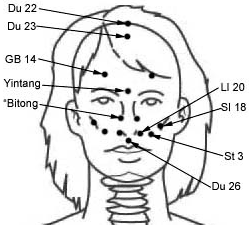Whether you accept it, avoid it or live somewhere in between, insurance coverage has become a defining issue for our profession. Patients increasingly expect to use their benefits, practitioners want to be compensated fairly for their time and expertise, and the system itself remains – at best – fragmented. The encouraging news is that coverage has expanded in meaningful ways. The challenging news is that reimbursement, across the board, remains inadequate.
Treatment of TMJ and Sinusitis With Microlight Electro-Acupuncture
I am often asked about some of my most powerful and effective experiences with microlight therapy. What often comes to mind are treatments of temporomandibular joint (TMJ) pain disorders and sinus problems. Because it is often surprising how profound clinical improvements in these conditions can be instigated by such gentle treatment, it leads me to believe that the facial cavities are especially sensitive to subtle energetic phenomenon.
Clearing The Sinuses
- Sinus pain and congestion is best treated with microcurrent probe electrodes, used bilaterally over indicated acupoints. I suggest settings of 80 Hz, with 2:1 mode if available, square waveform, and biphasic polarity. Increase current intensity until the patient feels a slight stinging sensation in sinuses. Treat each set of points for about 30 seconds. Use wetted cotton tips on probes and touch them to the following pairs of points.
- LI 20, bilaterally (in smile lines, lateral to ala nasi)
- Bi Tong, bilaterally (on sides of nose, in notch at junction of bone and cartilage)
- GV 26 (center of upper lip) and Yin Tang (between eyebrows)
- SI 18, bilaterally (below zygomaticus bone, inferior to outer corner of eyes)
- GB 20, bilaterally (in occipital hollows)
- LI 4, bilaterally (on prominence between thumb and forefinger)
- St 44, in web between second and third toes, on top of the foot
- Color therapy for sinusitis: indigo (drains), orange (decongestant), purple (for pain)
- Color therapy for TMJ: Blue on probe on outside of cheek for pain and to reduce inflammation


The first five points can be treated bilaterally on the face. The LI 4 and St 44 points can be treated together with polarized probes. Place the + probe on LI 4 and - probe on St 44 on the left side of the body, treat for 30 seconds, then repeat on the right side.
This treatment acts like dynamite on congested sinuses. Drainage can be expected in the majority of cases to begin within 30 minutes to 8 hours after stimulation. In resistant cases, repeat treatment daily. If the treatment does not work within one to three sessions, you should conclude that the patient has a particularly severe allergy that will need to be addressed first.
TMJ Pain Relief
Although temporomandibular syndromes are a complex set of disorders sometimes requiring surgical or orthopedic intervention, TMJ pain and spasm can often be treated efficiently and dramatically with microcurrents. This treatment can often prevent the need for surgery. To do this, you will need a TMJ extension electrode that stimulates intra-orally. Set your microcurrent instrument to the following: 75 uA, 0.3 Hz, sloped waveform, and biphasic polarity. Place the intra-oral electrode within the mouth on painful areas of the medial and lateral pterygoid muscles (or just ask the patient to put it where it hurts). Place the trigger probe on the outer cheek, and use the point-finding feature to locate several areas of high conductance on or around the TMJ. Stimulate each for 12-20 seconds. Frequently ask the patient to check their mouth-opening range for improvement. It is important to treat both sides of the mouth, even if only one side hurts. The following local and distal acupoints will be helpful:
- Local points around cheeks: St 5, 6, 7, GB 2, 3, SI 18, TW 17, 21, Tai Yang
- Distal points (+ polarity on face and - polarity on distal points): GB 20, LI 4, ST 44, GB 41
Complete the treatment by applying dual-probe stimulation to other affected muscles such as the masseter, SCM, temporalis, buccinator, frontalis and trapezius. Because this area is so sensitive, it is advised to use a small dose of treatment, and then wait to see results, rather than "pouring it on" in a single treatment session. Any electrical stimulation is contraindicated in patients with epilepsy without medical supervision.


